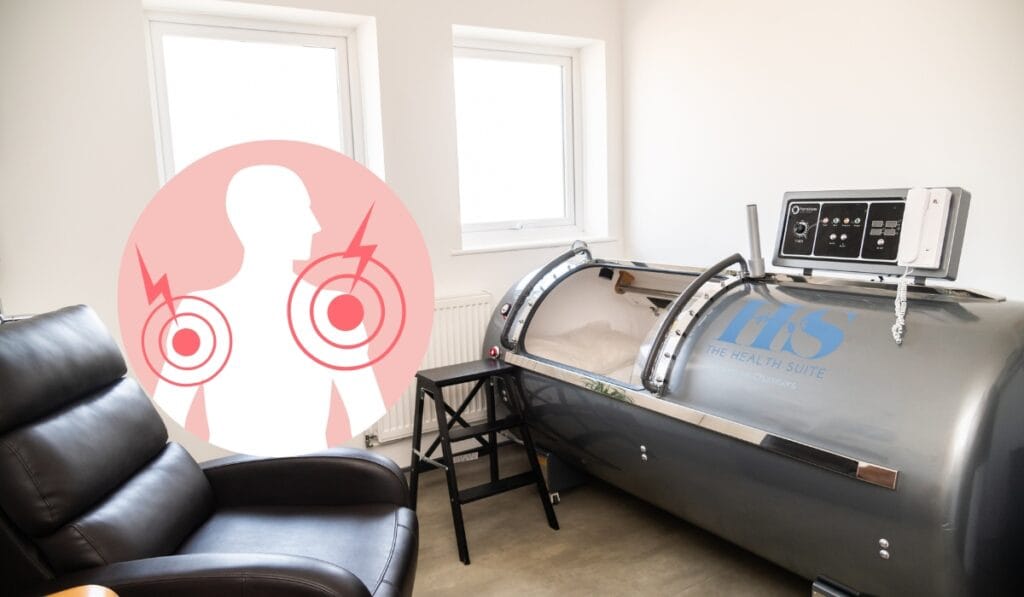Hyperbaric Oxygen Therapy (HBOT) involves breathing 100% oxygen within a pressurised chamber, which enhances oxygen absorption into the bloodstream due to increased pressure. Traditionally used for conditions like decompression sickness, HBOT is now gaining popularity for treating a variety of other conditions, including chronic inflammation.
What is Inflammation?
Inflammation is the body’s complex response to harmful things like germs, damaged cells, or irritants. It aims to protect by removing these harmful stimuli and starting the healing process. Inflammation can be:
- Acute: Short-term, such as a sore throat or a sprained ankle.
- Chronic: Long-term, such as inflammatory bowel disease, autoimmune conditions, and chronic joint pain.
Several cells and processes are involved in initiating and resolving the inflammatory response. While inflammation is a critical component of the body’s defence mechanisms and healing, chronic inflammation can lead to a variety of inflammatory conditions and ongoing health issues.
How HBOT Helps with Inflammation:
HBOT offers several mechanisms that can help reduce and manage inflammation:
- Increasing Oxygen Supply:
HBOT allows oxygen to dissolve into all body fluids, reaching damaged areas where circulation may be impaired due to inflammation. This promotes healing and reduces swelling and inflammation. - Modulating Immune Cells:
HBOT can modulate the activity of immune cells, enhancing their ability to fight infection and manage inflammation, which can reduce chronic inflammation. - Antimicrobial Effects:
As an antimicrobial adjuvant, HBOT is particularly beneficial for wound healing, especially in cases where microbial infections prevent wounds from healing. - Stimulating Angiogenesis:
HBOT promotes the growth of new blood vessels (angiogenesis), enhancing blood flow to inflamed and damaged areas, which aids in healing and reduces inflammation. - Enhancing White Blood Cell Activity:
HBOT enhances the activity of white blood cells, the body’s primary defence mechanism against infection and tissue damage. This enhancement helps prevent excessive inflammation that could lead to chronic conditions. - Reducing Oedema (Swelling):
HBOT has been shown to reduce oedema, the excess accumulation of fluids in tissues often caused by inflammation, which can be painful.
Conclusion
Hyperbaric Oxygen Therapy is emerging as a valuable tool in the fight against chronic inflammation. By improving oxygen supply, modulating immune response, enhancing antimicrobial effectiveness, promoting new blood vessel formation, boosting white blood cell activity, and reducing swelling, HBOT offers a comprehensive approach to managing and reducing inflammation. As research continues, HBOT may become a cornerstone in the treatment of various inflammatory conditions, providing relief and improving the quality of life for many patients.
Click here to learn more about Hyperbaric Oxygen Therapy and book an appointment.
References
- Cracchiolo, A.N., Palma, D.M., Genco, F., Palmeri, M., Teresi, A., Zummo, L., Gigliuto, C., Saporito, E.F.G., Ferruzza, A. & Piccoli, T. 2023, “Fibromyalgia: Could hyperbaric oxygen therapy make the difference? Our experience”, Clinical Case Reports, vol. 11, no. 9.
- De Wolde, S.D., Hulskes, R.H., Weenink, R.P., Hollmann, M.W. & Van Hulst, R.A. 2021, “The effects of hyperbaric oxygenation on oxidative stress, inflammation and angiogenesis”, Biomolecules, vol. 11, no. 8, pp. 1210.
- Efrati, S., Golan, H., Bechor, Y., Faran, Y., Daphna-Tekoah, S., Sekler, G., Fishlev, G., Ablin, J.N., Bergan, J. & Volkov, O. 2015, “Hyperbaric oxygen therapy can diminish fibromyalgia syndrome–prospective clinical trial”, PloS one, vol. 10, no. 5, pp. e0127012.
- Ortega, M.A., Fraile-Martinez, O., García-Montero, C., Callejón-Peláez, E., Sáez, M.A., Álvarez-Mon, M.A., García-Honduvilla, N., Monserrat, J., Álvarez-Mon, M. & Bujan, J. 2021, “A general overview on the hyperbaric oxygen therapy: applications, mechanisms and translational opportunities”, Medicina, vol. 57, no. 9, pp. 864.
- Oyaizu, T., Enomoto, M., Yamamoto, N., Tsuji, K., Horie, M., Muneta, T., Sekiya, I., Okawa, A. & Yagishita, K. 2018, “Hyperbaric oxygen reduces inflammation, oxygenates injured muscle, and regenerates skeletal muscle via macrophage and satellite cell activation”, Scientific reports, vol. 8, no. 1, pp. 1288.
- Rossignol, D.A., Rossignol, L.W., James, S.J., Melnyk, S. & Mumper, E. 2007, “The effects of hyperbaric oxygen therapy on oxidative stress, inflammation, and symptoms in children with autism: an open-label pilot study”, BMC pediatrics, vol. 7, pp. 1-13.
- Woo, J., Min, J., Lee, Y. & Roh, H. 2020, “Effects of hyperbaric oxygen therapy on inflammation, oxidative/antioxidant balance, and muscle damage after acute exercise in normobaric, normoxic and hypobaric, hypoxic environments: a pilot study”, International Journal of Environmental Research and Public Health, vol. 17, no. 20, pp. 7377.
Hyperbaric Oxygen Therapy (HBOT) is a medical treatment that entails breathing pure oxygen in a specially pressurised chamber, which enhances oxygen delivery to tissues, facilitating healing and reducing inflammation.

